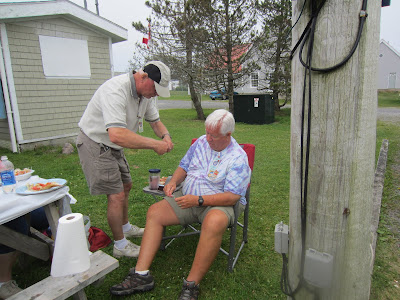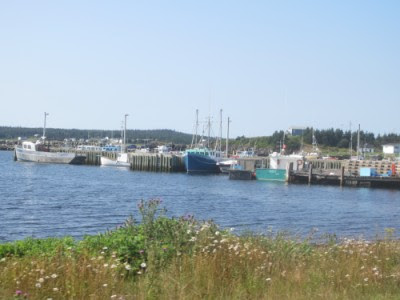Louisbourg, Nova Scotia
When we arrived and got settled in, it was time to set up for the cookout. We were able to secure 90 pounds of King Crab, which were cooked and flash frozen, from a packing house within walking distance from the camp. We steamed just enough to thaw and warm. No one went away hungry. Here is a few shots of everyone enjoying the meal.
Following the meal, every one got ready to go to Louisbourg Playhouse which is a theater next to the campgrounds.
One Night in a Cape Breton Kitchen
Playing at the Louisbourg Playhouse “One Night in a Cape Breton Kitchen” cast, from left, Lyndon MacKenzie, Erin Martell, Troy Young, Jason Kempt and Beverly MacLean. They feature songs and skits and The show is fast-paced and features a great mix of music and comedy. There’s a good dose of the fiddle stuff and dancing but there’s also some more contemporary music. This was the first time most of us saw a cajon played. Yep, it is a real instrument.
 |
| Louisbourg Playhouse |
 |
| Cape Breton Kitchen Players |
Fortress of Louisbourg
When we arrived at the visitors center, a bus shuttled us to the French Fortress of Louisbourg. Many of us made the mistake of wearing red (British colors). We were challenged at the entrance and finally convinced the guard we were not spies and were able to make it to the King’s Bakery for fresh baked oven bread. We took a guided tour and viewed demonstrations of music, dancing, cooking and military drills.
The Fortress of Louisbourg is the largest reconstruction project in North America. The original settlement was founded in 1713 by the French and developed over several decades into a thriving center for fishing and trade. Fortified against the threat of British invasion during the turbulent time of empire-building, Louisbourg was besieged twice before finally being destroyed in the 1760s. The site lay untouched until well into modern times, when archaeologists began to reconstruct the fortress as it was in the 18th century. We experienced life in Louisbourg during its heyday. There are more than a dozen buildings open to the public including three authentic working 18th century restaurants. During the summer months hundreds of re-enactors or “animators” of all ages, from wealthy merchants, poor soldiers and examples of public punishment populate the streets of the restored fortress working, playing, and living life as they would have in 1744.
 |
| Bus ride to the Fort |
 |
| Fort Gates |
 |
| Challenged by the guard |
 |
| Greeting and Orientation |
Sheumas and MacNeil on Piano and Fiddle
The Barra MacNeils are a Canadian musical group from Sydney Mines, Nova Scotia. The founding members of the group are siblings Sheumas, Kyle, Stewart, and Lucy MacNeil. In 2005 two additional brothers, Ryan and Boyd, joined the band. The Scottish island of Barra is the ancestral home of Clan MacNeil.
The MacNeil siblings are from Cape Breton Island and began performing together in 1980 while still teenagers (Lucy MacNeil being only 10 years old). They are classically trained musicians and alumni of Mount Allison University.
 |
| Sheumas on guitar |
 |
Nephew of Sheumas special appearance
|
Drive to Glace Bay, Nova Scotia
On our drive to Glace Bay we took some pictures of different coves and fishing villages that we are not used to seeing in our area. Here's a few pictures.
Miners Museum – Glace Bay, Nova Scotia
Situated the coast of Cape Breton Island, on a 15-acre site, the Miners Museum pays tribute to the region's long and rich history of coal mining. It is home to stories of miners and their families. The Museum is also home to the famous choir of miners - The Men of the Deeps. The exhibit area focuses on the geological development of Cape Breton's coal field and mining techniques. We saw a display of equipment and watched a video about miners, the companies they worked for, their unions and their families. Retired coal miners were our guides on a 20-minute expedition into a 1932 'room and pillar' mine. We learned all about trapper boys, boys as young as eight and nine whose job it was to open and close the underground doors when the boxes passed, controlling the air current plus the working conditions the miners had to endure.
 |
| Miners Museum Entrance |
 |
| Dressed and ready for the tour |
 |
| Tour Orientation |
 |
| Entrance to the Mine |
 |
| Drilling holes for the dynamite |
 |
| Would you believe an underground garden | | |
|
|
We were advised that 400' of the mine was only four and one-half feet tall. Seems like not one of us realized how hard it was to walk the 400' bent over. We know now why they issued walking sticks!!
Marconi National Historic Site of Canada
From this site in 1902, Marconi sent the first message across the Atlantic using electro-magnetic waves instead of wires. Late in October 1902, the Royal Italian Navy warship, Carlo Alberto, arrived in Sydney Harbour, arousing intense interest. Just a year before, on 12 December 1901, on the top of Signal Hill in St. John's, Newfoundland, Marconi had received a Morse code signal from his transmitter in England. The Anglo-American Telegraph Company forced Marconi to end his experiments in Newfoundland because it claimed he had violated its communications monopoly. Days later, he was in Ottawa dining with Prime Minister of finance and the most powerful Nova Scotian politician in Ottawa. In two more days, he came away with promises of $80,000. to finance a station to be located in Cape Breton near the mining town of Glace Bay.
 |
| Museum |
 |
| Marconi |
Men of the Deeps
Men of the Deeps Choir of Cape Breton coal miners was formed in 1966. It was founded at the instigation of Nina Cohen, whose enthusiasm for the preservation of mining culture had also led to the founding of the Miners' Museum in Glace Bay, NS. The Cape Breton Development Corporation, which employed most of the men, took an interest in the choir and hired a permanent director. They have toured mining communities, in the Maritime Provinces, Ontario, the Canadian North, the US, and have also performed in other countries.
Tomorrow we move to Baddeck, Nova Scotia to take a cruise and drive the Cabot trail.

































































No comments:
Post a Comment